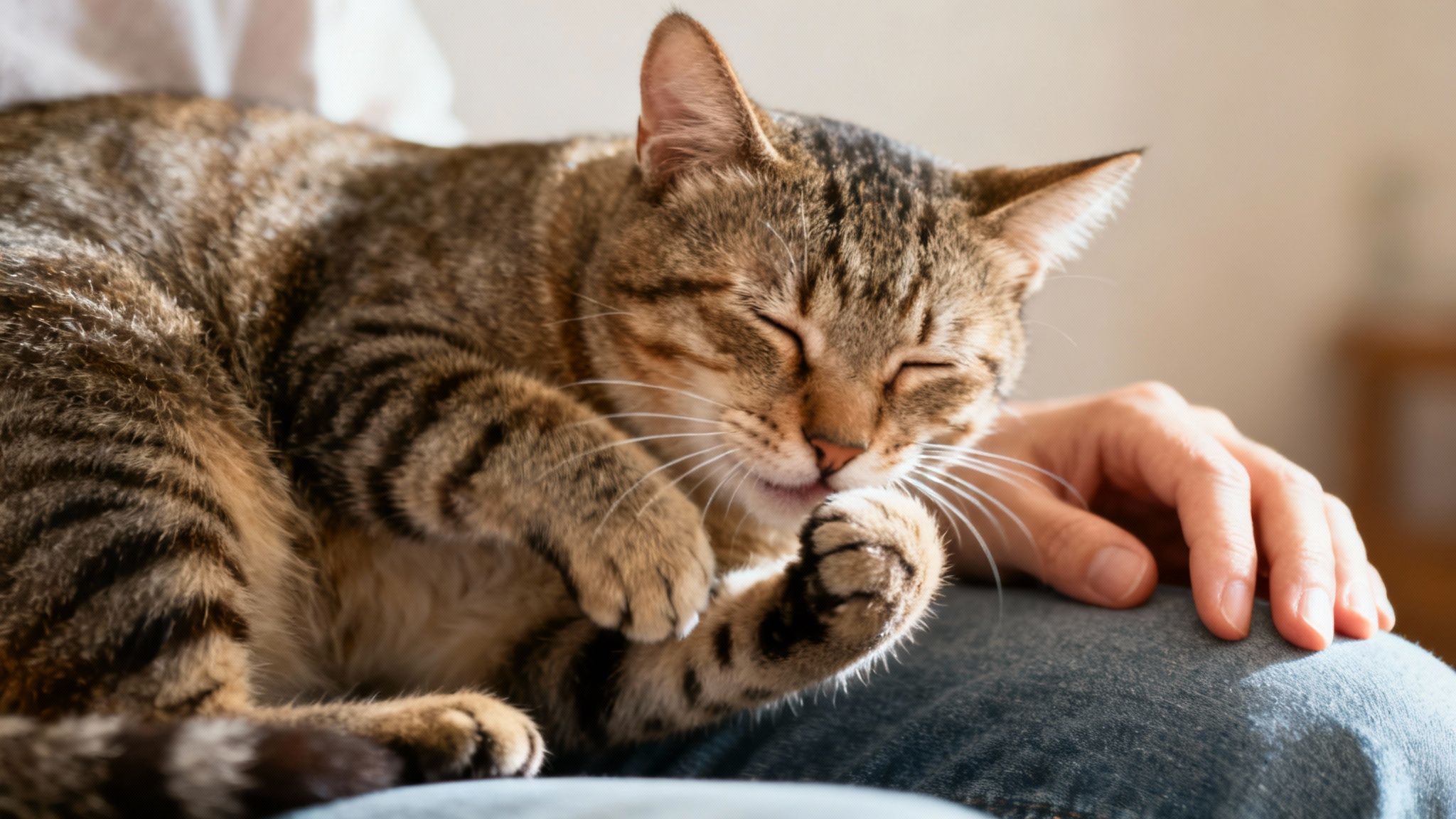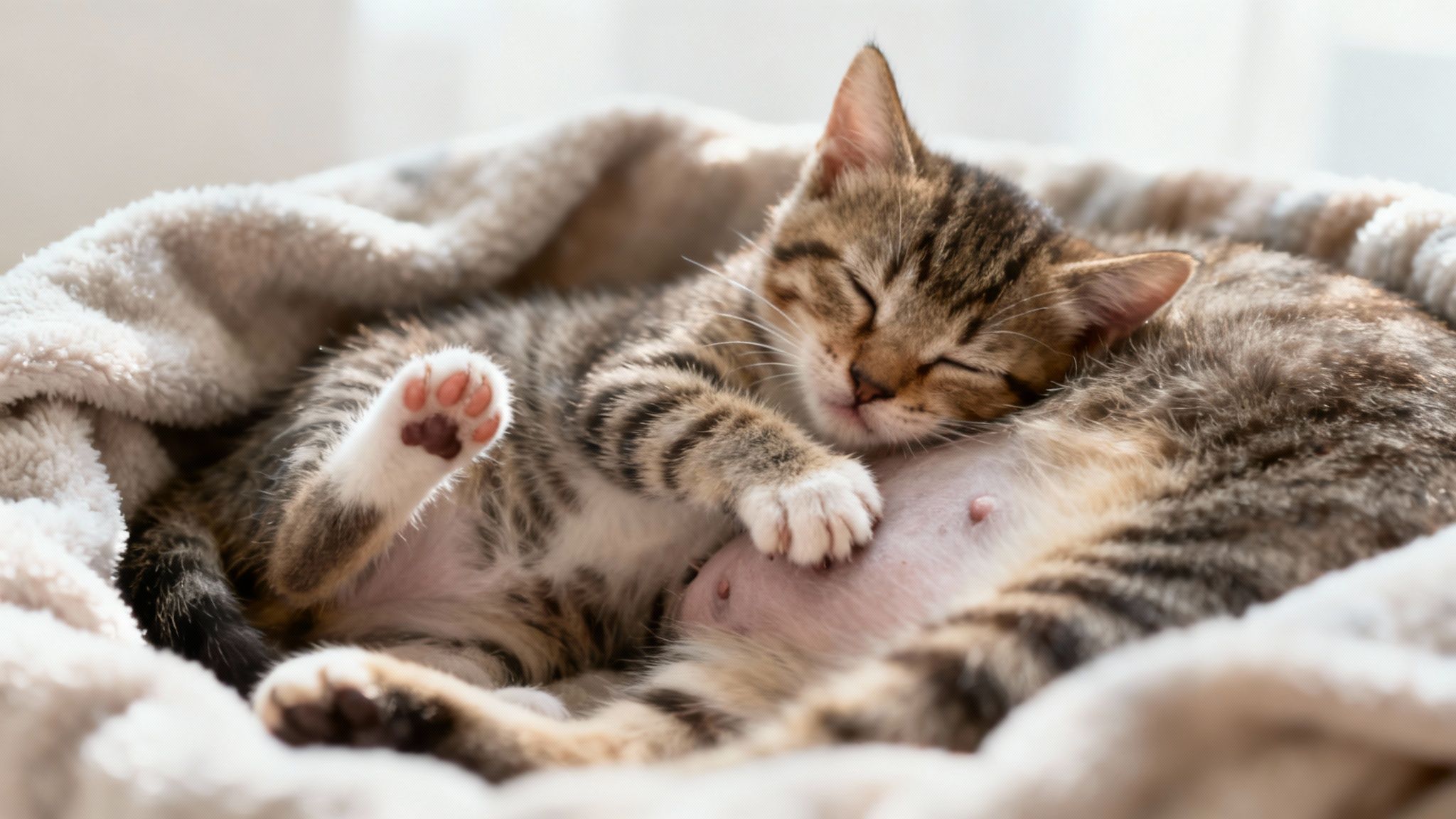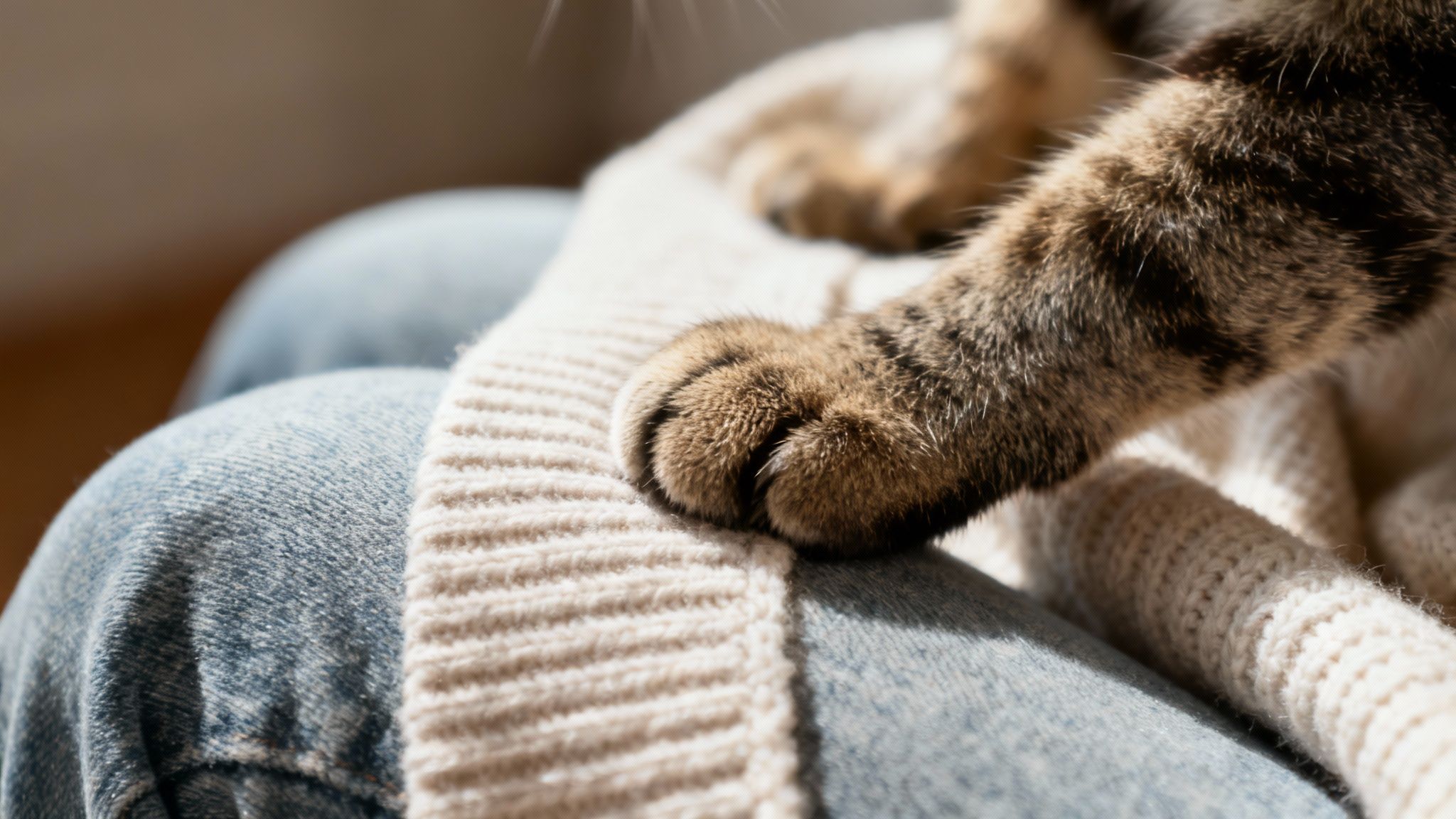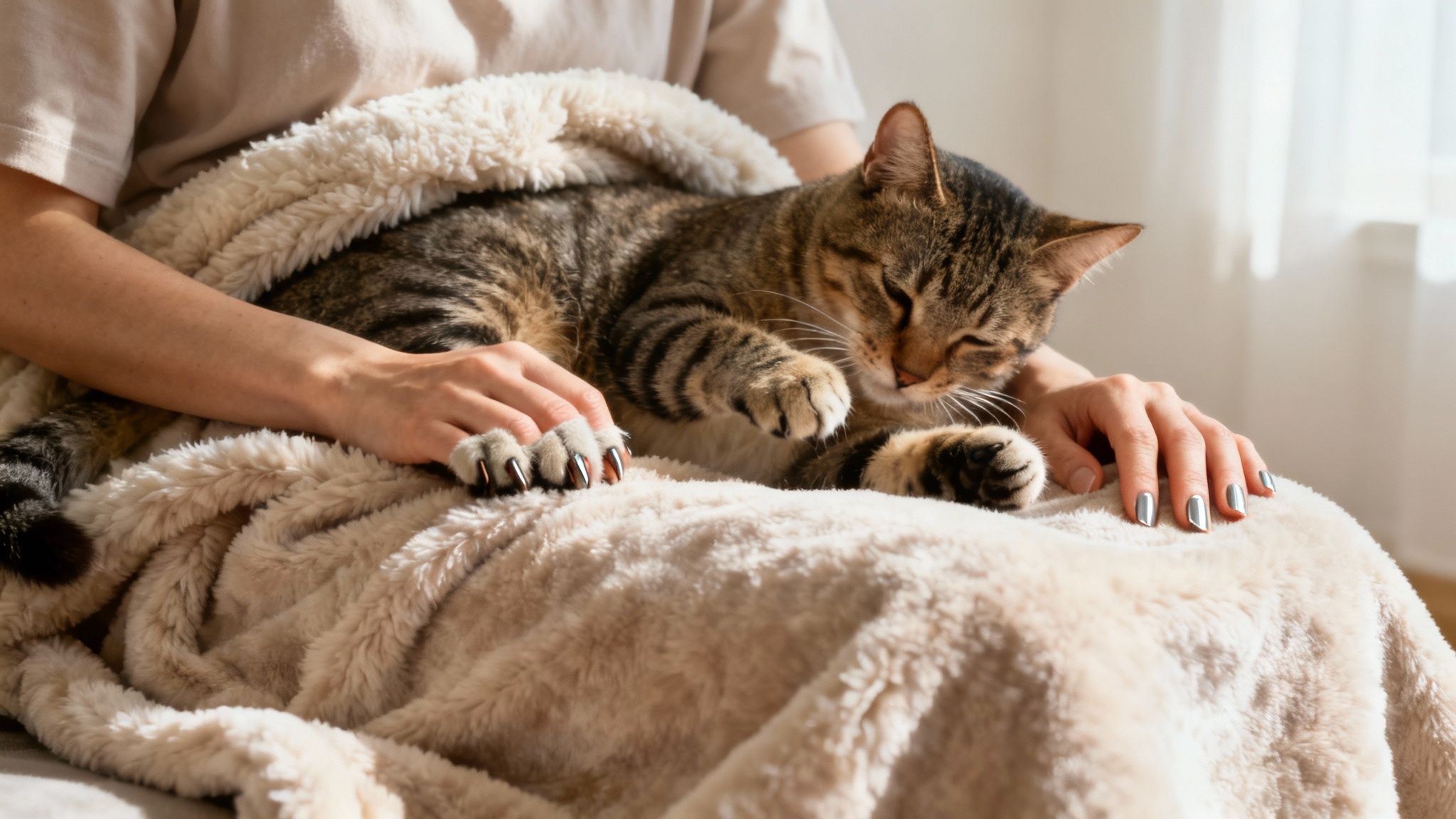If you’ve ever had your cat settle into your lap for a cuddle, you’ve probably felt it: that gentle, rhythmic pushing of their paws. It’s a moment most of us cat owners know and love. So, why do cats knead? At its heart, it’s a behaviour wired deep into their instincts from when they were kittens, and it’s almost always a sign of comfort, contentment, and affection.
Think of it as your cat’s way of saying, “I feel completely safe and happy with you.”
What Does My Cat’s Kneading Really Mean?
That rhythmic motion, often lovingly called “making biscuits,” is one of the most endearing things our cats do. It’s a tender little ritual that really strengthens the bond we have with them, but what’s actually going on in their heads? When we understand the ‘why’ behind it, we can appreciate it as more than just a cute habit; it’s a genuine piece of communication rooted in their earliest memories.

For most cats, kneading is a direct throwback to their kitten days. They would press their paws against their mother’s belly to get the milk flowing, an action that meant warmth, food, and total security. So when your grown-up cat starts kneading on your lap or a soft blanket, they’re tapping back into that profound feeling of comfort. Honestly, it’s a huge compliment. It means they see you as a source of safety and care.
A Common Language for Most Cats
You’re definitely not alone in puzzling over this behaviour. In fact, research shows it’s an incredibly common, almost universal, feline trait. According to a study in Applied Animal Behaviour Science, around 85% of domestic cats knead at some point. This instinct is clearly a fundamental part of how cats express themselves, connecting them to those early feelings of safety. You can find out more about these kittenhood instincts and how they carry through into adulthood.
This behaviour is a lovely, physical sign of the trust your cat has in you. It’s not just a random movement; it’s a message, loud and clear.
When your cat kneads on you, they are in a state of pure contentment. They are showing you that in their world, you represent safety, comfort, and love—the very best things a cat can feel.
To help you translate this charming behaviour, here’s a quick summary of what your cat might be telling you when they start making biscuits.
Quick Guide to Your Cat’s Kneading
This table breaks down the main reasons for kneading and what each one says about your cat’s state of mind.
| Reason for Kneading | What It Signifies | Your Cat’s Feeling |
|---|---|---|
| Kittenhood Instinct | Mimicking nursing behaviour to get milk. | Comforted & Secure |
| Showing Affection | A gesture of love and contentment towards you. | Happy & Loved |
| Scent Marking | Leaving their unique scent from paw glands. | Territorial & Confident |
| Making a “Nest” | Preparing a soft, comfy spot to rest. | Relaxed & Content |
| Stretching | A way to loosen up muscles after a nap. | Refreshed & Calm |
Understanding these different meanings helps you appreciate every push and pull as a little glimpse into your cat’s world. It’s a beautiful part of what makes them such special companions to us.
Tracing Kneading Back to Kittenhood
To get to the heart of why your cat kneads, we need to hop in a time machine and travel back to their very first days. This isn’t just some random quirk they’ve picked up; it’s a powerful instinct, deeply embedded from when they were a tiny, helpless kitten. Think of it as an echo from their past, telling a lovely story about how they feel right now, with you.

Picture a newborn kitten, all snuggled up with its mum and siblings. To get the milk they desperately need to survive, they instinctively push their little paws against their mother’s belly. This rhythmic pushing stimulates the milk flow, making sure they get all the nourishment they need to grow strong. During these crucial moments, kneading becomes hardwired with the most profound feelings a kitten knows: warmth, safety, and a full, happy tummy.
This link between the action and the feeling is incredibly strong. It’s a bit like how the smell of baking bread might instantly take you back to your grandmother’s kitchen. For your cat, kneading is their express ticket back to that ultimate state of comfort and security.
Why This Kitten Habit Continues
So, why does this behaviour stick around long after they’ve stopped nursing? When your grown-up cat starts kneading on your lap or their favourite blanket, they’re essentially re-enacting that comforting ritual from their youth. They aren’t looking for milk anymore, but they are trying to bring back that wonderful feeling of safety and contentment.
It’s a classic example of a retained juvenile behaviour. Interestingly, research shows that domestic cats often hang onto their kitten-like traits, like kneading and meowing at humans, well into their adult years. This is largely because we give them a safe, nurturing home where their ‘inner kitten’ feels free to come out and play. You can discover more about why our pet cats retain these behaviours on Science Focus.
In essence, when your cat kneads on you, they’re casting you in the role of their mother. It’s their ultimate way of showing deep trust and telling you they feel completely safe and loved in your care.
The Bond Between Nourishment and Affection
The instinct to knead is so tightly linked to early nourishment that it shapes how cats show affection for the rest of their lives. The positive feedback they got as kittens—food, warmth, and safety—cements kneading as a ‘happy’ action. This is why getting their nutrition right from the very beginning is so important for their overall development. If you’re wondering what fuels a growing kitten, have a look at our guide on the best brand of cat food for kittens.
So, the next time your cat curls up and starts “making biscuits” on your knee, take it as the highest compliment. It’s a clear, heartfelt message that you are their safe place, their comfort, and the absolute centre of their happy world.
Communicating Through Scent and Touch
While kneading is definitely a throwback to kittenhood, it’s also a surprisingly clever way your cat communicates with the world—and with you. This isn’t just about feeling cosy; it’s about sending a clear, personal message using the hidden languages of scent and touch.

Ever wondered if your cat is giving you a mini-massage? That’s pretty much what’s happening, but with a twist. Their paws are equipped with special scent glands, so when they push and pull, they’re actually depositing their own unique pheromones onto that surface.
Think of it like leaving your jacket on a favourite chair to save your spot. Your cat is essentially leaving a little scented note that says, “This is mine, and it makes me feel secure.”
Marking You as Their Safe Place
When your cat decides to knead on your lap, they’re paying you one of the highest compliments in the feline world. By pressing their paws into you, they are marking you as their personal territory—a safe, comforting part of their environment. This isn’t an act of dominance, but one of deep trust and affection. They are mixing their scent with yours, creating a combined smell that reassures them that everything is safe and sound.
This behaviour is a powerful sign of their emotional state. Here in the UK, veterinary behaviourists often stress that kneading usually means a cat feels completely secure and relaxed, a sure indicator of a strong bond with their owner. It’s a double-whammy of affection and territory marking, letting everyone know that you are a source of safety.
By kneading on you, your cat is effectively saying, “You are my family. You are my safe space.” This simple action transforms your lap into a sanctuary, scented with the reassuring aroma of home.
This complex communication just goes to show how much is going on beneath the surface of their everyday actions. Learning to interpret these signals helps us appreciate the depth of our connection, and you can delve deeper into the nuances of your cat’s communication style in our other guides. As we explore how cats use touch, it’s also interesting to understand other ways cats communicate through touch, such as when they nibble you, to get a fuller picture of their affectionate language.
Decoding Your Cat’s Kneading Body Language
To really get to the bottom of why your cat kneads, you have to look beyond just their paws. Kneading is rarely a solo act; it’s more like the main event in a full performance of feline body language. When you start observing the whole picture, you can stop just seeing the behaviour and start truly understanding what your cat is feeling in that moment.
Next time your cat starts up their little massage routine, take a second to notice what else is going on. Is their body all floppy and loose? Are their eyes half-closed in that dreamy, blissful way they do? These little clues are the supporting cast that give the kneading its real meaning.
Signs of a Happy and Content Cat
Happy kneading is a lovely thing to witness, and it almost always comes with a whole symphony of other contented behaviours. When your cat is kneading out of sheer joy and feeling safe, you’ll probably spot a few of these signs.
- Loud Purring: This is the most obvious clue. A deep, rumbling purr is the classic soundtrack to a happy kneading session.
- Sleepy Eyes: Your cat might have their eyelids half-closed or give you those slow, deliberate blinks. We often call this a “cat kiss,” and it’s a massive sign of trust.
- Relaxed Tail: Look for a tail that’s either still or just gently swishing from side to side. A relaxed posture shows they feel completely at ease.
- Drooling: Some cats get so lost in the blissful moment that they might even drool a little. It’s a sure sign they’ve reached peak relaxation!
When you see these signs all together, you can be pretty confident that your cat’s kneading is a message of pure love and contentment. They’re in their happy place, and they’re sharing it with you.
When Kneading Might Signal Stress
While kneading is overwhelmingly a positive thing, it can sometimes be a self-soothing mechanism for a cat that’s feeling anxious or unwell. The crucial difference is all in the surrounding body language. A cat kneading from stress looks very different from a relaxed one.
Paying attention to context is everything. A cat kneading peacefully on your lap is communicating something entirely different from one kneading frantically while hiding under a bed. Your observation skills are the key to unlocking their true feelings.
It can be hard to tell the difference at first, but with a bit of practice, you’ll become an expert at reading your cat’s unique signals. This table breaks down some of the key things to look for.
Interpreting Your Cat’s Kneading Signals
| Body Language Signal | Signs of Content Kneading | Signs of Stress Kneading |
|---|---|---|
| Pace & Rhythm | Slow, rhythmic, and gentle pushing motions. | Frantic, urgent, or compulsive pace. |
| Body Posture | Loose, floppy, and relaxed muscles. | Tense, rigid, or crouched body. |
| Eyes | Half-closed, sleepy-looking, slow blinking. | Wide, dilated pupils, staring intently. |
| Tail | Still or a gentle, slow swish. | Sharp, fast twitching or thumping against a surface. |
| Vocalisations | Loud, deep purring. | Insistent meowing, yowling, or other distress sounds. |
If you’re ever worried, watch for these accompanying signs of stress:
- Tense Body: A stressed cat’s muscles will be rigid, not soft and relaxed.
- Frantic Pace: The kneading might seem more urgent or compulsive, not rhythmic and gentle.
- Tail Flicking: A tail that is twitching sharply or thumping can be a sign of irritation or anxiety.
- Vocalisation: Instead of purring, a stressed cat might be meowing insistently or making other sounds of distress.
Becoming a keen observer of your cat’s complete body language doesn’t just satisfy your curiosity; it deepens the incredible bond the two of you share.
How to Handle Kneading When It Becomes Painful
We all love it when our cats curl up on our laps and start to knead. It’s one of the purest signs of their love and contentment. But let’s be honest—when those little claws start digging into your leg, even through a pair of jeans, that blissful moment can turn a bit ouchy!
The good news is you don’t have to push your cat away or stop this lovely behaviour. It’s all about managing the situation gently so you and your cat can both enjoy this special bonding time, completely pain-free. Think compassionate redirection, not punishment.

After all, your cat isn’t trying to hurt you. They’re just lost in a moment of pure bliss. Telling them off for a natural instinct would only confuse them and could easily damage the wonderful bond you share.
Create a Designated Kneading Blanket
One of the easiest and most effective tricks in the book is to introduce a special “kneading blanket.” Just keep a thick, soft blanket folded and ready on the sofa or your favourite chair. The moment your cat hops up and looks ready to start making biscuits, gently slide the blanket between their paws and your lap.
Most cats will happily accept this cosy new surface and carry on kneading without missing a beat. This simple, positive step lets them express themselves while keeping you comfortable. You’re not stopping them; you’re just giving them a better place to do it.
By providing an approved spot for kneading, you validate your cat’s feelings of comfort and security. You’re sending a clear message: “I love when you do this, let’s just make it comfy for both of us.”
This little act reinforces that your lap is a safe and welcoming spot, which only strengthens your connection. It respects their need to knead while protecting you from those accidental scratches.
Keep Their Claws Trimmed
Another really practical step is to keep your cat’s claws neatly trimmed. When their nails get too long, even the gentlest kneading can feel like you’re being pricked by tiny needles. A regular trim blunts those sharp tips, making their biscuit-making sessions far more pleasant for you.
If you’re not confident about doing it yourself, your vet or a professional groomer will be happy to help. It’s a simple bit of maintenance that benefits everyone and helps protect your furniture and blankets, too.
Redirect to Appropriate Surfaces
Sometimes, a cat’s urge to knead is part of a bigger need to stretch and work their claws. If you find them kneading on your furniture or carpets, it could be a hint that they need a better outlet. This is where a good scratching post or cat tree comes into its own.
Giving them appealing scratching surfaces allows them to stretch their paws, flex their claws, and mark their territory in a way you can both live with. If you’re looking for the perfect one for your home, our guide to the best cat trees for indoor cats can help you find one they’ll absolutely adore. By gently redirecting them to these spots, you give them a positive alternative that keeps their instincts happy.
Even after all this, you might still have a few lingering questions about your cat’s particular kneading style. We get it! Every cat is an individual, and figuring out their little quirks is one of the great joys of being their person. Here are our thoughts on some of the most common queries we hear from fellow cat lovers.
Why Does My Cat Only Knead Me?
If your cat saves their special “biscuit-making” sessions just for you, you should take it as the highest possible compliment. Honestly, it’s a powerful sign of an incredibly deep and special bond.
It means they see you as their ultimate source of safety and comfort, almost exactly how a kitten sees its mother. You are their safe person. By choosing only you, they’re essentially saying you are the absolute centre of their world, showing a level of trust that is truly heartwarming.
Is It Normal for Cats to Suckle on Blankets While Kneading?
Yes, this is completely normal and actually quite common, especially in cats that might have been weaned a touch early. The two behaviours are instinctually welded together from their earliest days: kneading to get the milk flowing and suckling to drink it.
When your adult cat does this, they are tapping right back into that feeling of ultimate comfort and security. It’s a harmless self-soothing habit that simply shows they feel incredibly relaxed and content in their surroundings. In the same way our cats hunt for the softest spots to knead, we humans also appreciate the simple comfort of things like the perfect pair of soft slippers for home.
My Cat Has Never Kneaded. Is Something Wrong?
Not at all! While most cats do knead, every single one is an individual. A lack of kneading isn’t a red flag that your cat is unhappy or that you share a weaker bond.
Your cat simply has their own unique love language. They might show their affection and contentment in other ways, like a rumbling purr, a gentle head-butt against your leg, or those loving slow blinks from across the room.
As long as your cat seems happy, relaxed, and shows you affection in their own way, there is absolutely no need to worry. Just enjoy their special way of telling you they love you.
Understanding your cat’s behaviour is central to giving them the best care, especially when you can’t be there. At K9 Time, we offer professional cat sitting services where we treat your feline friend with the same empathy and attention you do, making sure they feel safe and content while you’re away. To learn more about our reliable care in Sheffield, visit us at https://k9time.co.uk.

